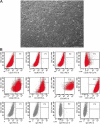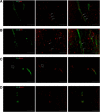Human adipose tissue-resident monocytes exhibit an endothelial-like phenotype and display angiogenic properties
- PMID: 24731246
- PMCID: PMC4055093
- DOI: 10.1186/scrt438
Human adipose tissue-resident monocytes exhibit an endothelial-like phenotype and display angiogenic properties
Abstract
Introduction: Adipose tissue has the unique property of expanding throughout adult life, and angiogenesis is required for its growth. However, endothelial progenitor cells contribute minimally to neovascularization. Because myeloid cells have proven to be angiogenic, and monocytes accumulate in expanding adipose tissue, they might contribute to vascularization.
Methods: The stromal vascular fraction (SVF) cells from human adipose tissue were magnetically separated according to CD45 or CD14 expression. Adipose-derived mesenchymal stromal cells (MSCs) were obtained from SVF CD45- cells. CD14+ monocytes were isolated from peripheral blood (PB) mononuclear cells and then cultured with SVF-derived MSCs. Freshly isolated or cultured cells were characterized with flow cytometry; the conditioned media were analyzed for the angiogenic growth factors, angiopoietin-2 (Ang-2), vascular endothelial growth factor (VEGF), basic fibroblast growth factor (bFGF), hepatocyte growth factor (HGF), granulocyte colony-stimulating factor (G-CSF), and granulocyte macrophage colony-stimulating factor (GM-CSF) with Luminex Technology; their angiogenic capacity was determined in an in vivo gelatinous protein mixture (Matrigel) plug angiogenesis assay.
Results: CD45+ hematopoietic cells within the SVF contain CD14+ cells that co-express the CD34 progenitor marker and the endothelial cell antigens VEGF receptor 2 (VEGFR2/KDR), VEGFR1/Flt1, and Tie2. Co-culture experiments showed that SVF-derived MSCs promoted the acquisition of KDR and Tie-2 in PB monocytes. MSCs secreted significant amounts of Ang-2 and HGF, but minimal amounts of bFGF, G-CSF, or GM-CSF, whereas the opposite was observed for SVF CD14+ cells. Additionally, SVF CD14+ cells secreted significantly higher levels of VEGF and bFGF than did MSCs. Culture supernatants of PB monocytes cultured with MSCs contained significantly higher concentrations of VEGF, HGF, G-CSF, and GM-CSF than did the supernatants from cultures without MSCs. Quantitative analysis of angiogenesis at 14 days after implantation demonstrated that neovascularization of the implants containing SVF CD14+ cells or PB monocytes previously co-cultured with MSCs was 3.5 or 2 times higher than that observed in the implants with SVF-derived MSCs. Moreover, immunofluorescence of Matrigel sections revealed that SVF CD14+ cells differentiated into endothelial cells and contributed to vascular endothelium.
Conclusions: The results from this study suggest that adipose tissue-resident monocytes should contribute to tissue vascularization. Because SVF CD14+ cells were more efficient in inducing angiogenesis than SVF-derived MSCs, and differentiated into vascular endothelial cells, they may constitute a new cell source for cell-based therapeutic angiogenesis.
Figures








Similar articles
-
An In Vitro Co-Culture Model of Bone Marrow Mesenchymal Stromal Cells and Peripheral Blood Mononuclear Cells Promotes the Differentiation of Myeloid Angiogenic Cells and Pericyte-Like Cells.Stem Cells Dev. 2021 Mar;30(6):309-324. doi: 10.1089/scd.2019.0171. Epub 2021 Mar 1. Stem Cells Dev. 2021. PMID: 33499756
-
Combined administration of G-CSF and GM-CSF stimulates monocyte-derived pro-angiogenic cells in patients with acute myocardial infarction.Cytokine. 2006 Apr;34(1-2):56-65. doi: 10.1016/j.cyto.2006.03.014. Epub 2006 May 15. Cytokine. 2006. PMID: 16698275
-
Fibroblast-Negative CD34-Negative Cells from Human Adipose Tissue Contain Mesodermal Precursors for Endothelial and Mesenchymal Cells.Stem Cells Dev. 2015 Oct 1;24(19):2280-96. doi: 10.1089/scd.2015.0013. Epub 2015 Jul 20. Stem Cells Dev. 2015. PMID: 26068131
-
Therapeutic angiogenesis for revascularization in peripheral artery disease.Gene. 2013 Aug 10;525(2):220-8. doi: 10.1016/j.gene.2013.03.097. Epub 2013 Apr 5. Gene. 2013. PMID: 23566831 Review.
-
Systematic review: Advances of fat tissue engineering as bioactive scaffold, bioactive material, and source for adipose-derived mesenchymal stem cells in wound and scar treatment.Stem Cell Res Ther. 2021 Jun 2;12(1):318. doi: 10.1186/s13287-021-02397-4. Stem Cell Res Ther. 2021. PMID: 34078470 Free PMC article.
Cited by
-
Shift toward Mechanical Isolation of Adipose-derived Stromal Vascular Fraction: Review of Upcoming Techniques.Plast Reconstr Surg Glob Open. 2016 Sep 7;4(9):e1017. doi: 10.1097/GOX.0000000000001017. eCollection 2016 Sep. Plast Reconstr Surg Glob Open. 2016. PMID: 27757339 Free PMC article.
-
Autologous Immune Cell-Based Regenerative Therapies to Treat Vasculogenic Erectile Dysfunction: Is the Immuno-Centric Revolution Ready for the Prime Time?Biomedicines. 2022 May 8;10(5):1091. doi: 10.3390/biomedicines10051091. Biomedicines. 2022. PMID: 35625828 Free PMC article. Review.
-
Stromal Vascular Fraction and its Role in the Management of Alopecia: A Review.J Clin Aesthet Dermatol. 2019 Nov;12(11):35-44. Epub 2019 Nov 1. J Clin Aesthet Dermatol. 2019. PMID: 32038756 Free PMC article. Review.
-
Linker histone variant H1.2 is a brake on white adipose tissue browning.Nat Commun. 2023 Jul 6;14(1):3982. doi: 10.1038/s41467-023-39713-w. Nat Commun. 2023. PMID: 37414781 Free PMC article.
-
The Immune-Centric Revolution Translated into Clinical Application: Peripheral Blood Mononuclear Cell (PBMNC) Therapy in Diabetic Patients with No-Option Critical Limb-Threatening Ischemia (NO-CLTI)-Rationale and Meta-Analysis of Observational Studies.J Clin Med. 2024 Nov 28;13(23):7230. doi: 10.3390/jcm13237230. J Clin Med. 2024. PMID: 39685690 Free PMC article. Review.
References
-
- Shi Q, Rafii S, Wu MH, Wijelath ES, Yu C, Ishida A, Fujita Y, Kothari S, Mohle R, Sauvage LR, Moore MA, Storb RF, Hammond WP. Evidence for circulating bone marrow-derived endothelial cells. Blood. 1998;92:362–367. - PubMed
Publication types
MeSH terms
LinkOut - more resources
Full Text Sources
Other Literature Sources
Medical
Research Materials
Miscellaneous

